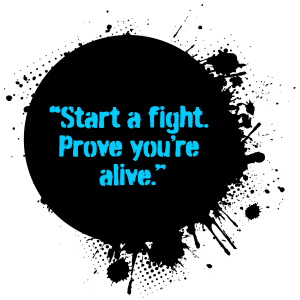When you have insomnia, you’re never really asleep… and you’re never really awake.
With insomnia, nothing’s real. Everything’s far away. Everything’s a copy of a copy of a copy…
In 1999, the world was introduced to Tyler Durden – the confident, cool and fearless alter-ego of a mild-mannered and life-weary insomniac. As opposed to simply being a passenger coasting through life, Tyler had power. He inspired. When he spoke, others listened. He brought the fight.
Why, all these years later, are we talking about Tyler? Because in comms, being part of the fight – playing an active role in tackling the major challenges your organisation is facing – is exactly where you need to be.
If comms teams remain as purely passive bystanders to the cause, assigned to just sit on the side lines and never being fully involved in the conversations that really count, then the potential to achieve something truly spectacular is lost.

That’s because comms can be a powerful force for good within any organisation. If you can reach below the surface and understand how an organisation should function and the things that are getting in the way of that, then you can effect real change. Helping the organisation more effectively to tackle the stuff that matters and achieve its goals at the same time.
So, what are some of the key organisational fights that comms teams can help to grapple with? Here we share some inspiring examples…
Mental health
Positive mental health impacts on productivity and energy levels. A happier and more productive workforce results in better business outcomes for the organisation. Mental health is defined by the World Health Organization as ‘a state of well-being in which every individual realizes his or her own potential, can cope with the normal stresses of life, can work productively and fruitfully, and is able to make a contribution to her or his community.’
Employee wellbeing is rooted in workplace culture and comms teams play an important role in communicating those values and also in starting important conversations.
A culture of trust
According to the 2019 Edelman Trust Barometer, trust has changed profoundly in the past year – people have shifted their trust to the relationships within their control, most notably their employers. And this presents comms teams with an opportunity to strengthen that culture of trust further.
The four dimensions of trust identified by Edelman are:
- Ability: The perception that the organisation is good at what it does
- Integrity: The conviction that it is honest
- Dependability: The expectation that it will keep its promises
- Purpose: The sentiment that it is trying hard to have a positive impact on society
KP Snacks is an organisation that’s taking trust seriously and investing in ways to demonstrate that, not only to its consumers, but to its employees too. In particular, there’s a heavy focus on sustainability, honesty and purpose, addressing all four of Edelman’s dimensions of trust. Their ‘Taste for Good’ initiative demonstrates a commitment to providing colleagues with an environment that is fun, rewarding and enables them to be the best they can be. According to KP Snacks, ‘by continuing to listen to, invest in and grow our people we believe our business will continue to be successful today and for generations to come.’
Digital transformation
We come across many transformation programmes that centre on the people, process, technology triangle. But it’s not unusual for the people part to be left behind in favour of the shiny digital advancements that can take priority. And when employee experience is not part of the journey, the entire initiative is at risk.
This article by Social Chorus delves into the ways internal comms teams can position themselves at the centre of digital transformation initiatives when executive buy-in and a comprehensive communications strategy exists.
 Any transformation project will inevitably be complex and wide reaching, touching every part of your organisation. And will require a broad range of deliverables to ensure the message is shared with the right people, in the right way. We created this animation for Braskem to help them break down some of those complexities and spread the word about their digital transformation with team members across the globe.
Any transformation project will inevitably be complex and wide reaching, touching every part of your organisation. And will require a broad range of deliverables to ensure the message is shared with the right people, in the right way. We created this animation for Braskem to help them break down some of those complexities and spread the word about their digital transformation with team members across the globe.
Talent and skills growth
According to this year’s CEO survey from PwC, the availability of skills is the top business concern for UK business leaders at 79%. ‘Organisations must work harder to identify, nurture and retain the right skills for the continually evolving digital age and upskilling and retraining is seen as the most important factor to close the skills gap.’
Alshaya Group introduced ‘Learning Links’, an online Learning Management System that its 53,000 employees could benefit from, anytime, anywhere, on any device, and in their language of choice. It was the biggest L&D change in Alshaya’s history, helping to address recruitment and retention issues, upskilling workers for technological change and embedding a culture of adaptability and continuous learning. The campaign led by the communications team achieved a 95% sign up (38,000 employees) within the first 100 days, confidently positioning the team as a force to be reckoned with. You can read more about Alshaya’s commitment to empowering people development here.
Diversity & inclusion
Diversity and inclusion in the workplace can drive stronger engagement, business performance and results. Taking positive action in this space should look to address all sorts of factors, including age, geography, gender, sexual orientation and ethnicity. To deliver workplace inclusion, organisations and their leaders need to work with comms team to communicate the vision and expectations of each individual. Being vocal about the benefits of embracing people from a diverse range of backgrounds.
Johnson & Johnson’s ‘You Belong’ campaign leads the way in ensuring staff feel included in the workplace.
Health and Safety
Health and safety isn’t always the most exciting message to be communicating, but it’s an important one.
 Corporate communicators have an opportunity to explore new strategies, trends and innovative techniques, and to introduce actionable tactics that successfully engage employees in safety matters. Communicating such procedures can be difficult and so bringing it to life through creative thinking, planning and conversations is crucial. It should be rooted in changing perceptions and behaviours, by showing employees these issues are worth their effort and attention.
Corporate communicators have an opportunity to explore new strategies, trends and innovative techniques, and to introduce actionable tactics that successfully engage employees in safety matters. Communicating such procedures can be difficult and so bringing it to life through creative thinking, planning and conversations is crucial. It should be rooted in changing perceptions and behaviours, by showing employees these issues are worth their effort and attention.
Here is a great example from Merlin Entertainment and it’s ‘Protect the magic’ initiative.
Cybersecurity
Cyberattacks are a growing threat for organisations everywhere and criminals are developing increasingly sophisticated ways to disrupt systems and steal data. Employees and employee error can often be at the heart of an attack, with phishing emails one of the key routes in for criminals. Raising awareness and educating employees and senior leaders about such risks, is therefore critical. Plus, were an attack to happen, a quick and effective communications response is again going to be vital, to help mitigate the potential damage.
We created this animation to help The University of Manchester share important messages about Cyber Security in a rather unexpected way.
To reach your full potential and support your organisation to achieve the same, comms teams need to be involved in these big conversations. They need to be an active participant in the fights that organisations are facing, not sitting passively on the side lines.
Be brave. It’s time to fight the big fight.

















